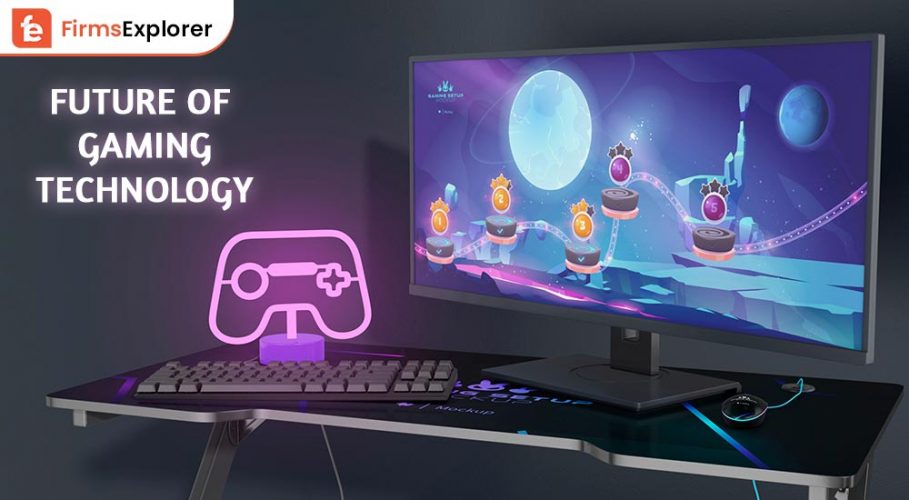
From playing through 8-bit graphics and only two colors to playing with haptics, the trajectory of the gaming industry has come a long way. Looking at the incredible developments, one can assume that the future of the gaming industry will unfold a lot more than our imagination. With a variety of game genres, realistic graphics, and multiple options to choose from, gaming has risen as the favorite mode of entertainment for every third person we meet.
If you have played games like Fifa 22, God of War, or Myst Island, then you can understand how gaming has evolved in the last thirty years. Back then, blue was the main color of blocky and pixelated graphics. Now, we have photo-realistic graphics that can take us to immersive environments. This indicates how far the future of gaming development technology may go. With this said, let us understand a little more about the current scenario of the gaming industry.
The future of the gaming industry looks bright with the adaptation of next-gen gaming technologies. With the launch of advanced consoles like PS5 and Xbox Series X to the Oculus Quest 2, the big gaming companies are introducing features that attract the new generation of video game fanatics. Graphics, online connectivity, and processing power are some of the factors that influence next-generation gaming. Therefore, gaming companies now pay close attention to these factors. With this, we can trace the future of gaming by looking at previous developments. For instance, PS5 brought HD graphics, then PS4 was launched with 4k resolution, and finally, PS5 came in with ray technology that produces real-time reflections and glow effects.
However, this certainly does not mean that the bright future of the gaming industry will be only seen through consoles. The dramatic advancement of PC hardware and a wide variety of software now have the potential to provide a top-notch gaming experience. Nvidia’s GeForce RTX 30 Series GPUs now power the G15 AMD Ryzen Edition gaming laptop and the new Alienware Aurora Ryzen Edition desktop that leave the player with a highly immersive experience, delivering lightning-fast refresh rates, realistic graphics, and more. Though with this information, you can picture the future of gaming, let us look at its literal meaning.
Well, by understanding the developments mentioned above, you can predict the future of gaming can deliver an entirely immersive experience to players. Broaden your imagination, and you will see yourself controlling a fantasy place through your mind and body. Rapid technological advancements and the esports gaming community are all set to continuously improve gaming experiences. With this said, let us now know the key technologies that will play a fundamental role in shaping the future of the gaming industry.
The key technologies that are at the forefront of delivering new gaming experiences are-
Let us look at how each one of these technologies is shaping the future of the gaming industry.
It is by far the most popular technology contributing to the future of gaming. Pokemon Go being viral is an example of this fact. It’s an augmented reality mobile game in which digital objects or colorful critters, in this case, Pokémon, overlay the player’s natural field of view. 2016 was all about people strolling around with their smartphones to catch pokemon.
The interplay of virtual characters with real-world locations is the reason behind the unencumbered success of Pokemon Go. People are embracing the new technology, particularly because it does not completely eliminate reality. So far, AR gaming is gaining terrific traction on mobile phones. However, large tech investors such as Apple, Meta, Snap, and Magic Leap believe the future of gaming with AR will take off through specially-developed AR glasses.
The buzz about virtual reality is not new in the gaming industry. It’s a decades-old hope that pro gamers look forward to. VR has surely been late in delivering its promises to gaming. However, unlike the other components of the gaming industry, virtual reality has become a niche category. Thus, VR gaming alone accounts for a little less than half the sales of the entire gaming industry. While some experts still believe that the technology is lagging behind, tech giants like Meta, Sony, Valve, and more are wrapping their heads around VR to get it right for their consumers. A considerable amount of research, investments, and time is being dedicated to VR hardware and games.
The challenges of bulky hardware and high prices are now holding back the hype of VR gaming. Though VR promises to play a key role in the future of the gaming industry, the strappy and tight headsets make the player uncomfortable, ultimately making them think twice about buying VR games. Another reason why buyers are avoiding VR gaming is its nature of socially isolating people from the physical world. Thus, people are hesitant to buy this cutting-edge gaming technology. However, if headsets become slimmer and more comfortable, and VR unlocks more socializing possibilities for players, then it stands a huge chance of earning a prominent place in the future of gaming.
Read Also – Difference Between Augmented Vs Virtual Reality
High-fidelity games feature cutting-edge graphics and gameplay. HD graphics have been serving the future of the gaming industry for decades. The new generation of cutting-edge smartphones, high-performance graphics chips, gaming consoles, and processors is what is driving the high demand for high-fidelity games. For a more immersive gaming experience, gaming companies are motivated to build graphic cards that support high-fidelity gaming. The new technology will revolutionize gaming and provide more lifelike graphics and experiences. Thus, gamers are expected to be significantly impacted by high-fidelity visuals.
A high GPU demand, sophisticated 3D graphics, challenging gameplay, and characters with AI are all characteristics of high-fidelity games. So, it is highly possible that the demand for high-fidelity graphics will increase simultaneously as advanced smartphones and other cutting-edge technologies keep flowing into the market.
Read Also – Best Free Steam Games for Mac
AI has the potential to advance as well as sustain the future of the gaming industry. The long-term objective of artificial intelligence research is the development of machinery that can carry out any task that humans can. With the use of this technology, we are able to create video games with incredibly lifelike images and character interactions. A game’s ability to adapt to its players is already being made possible by current developments in artificial intelligence. It’s so adaptive that video games in the future may be able to gather information about their users and modify the experience accordingly. Players who favor action games, for instance, might be given more action-focused tasks, whilst those who prefer strategic gameplay might be given more difficult puzzles.
Read Also – Best Game Name Generators Online
Though the advertising of cloud gaming may seem hyperbolic, a few of its assertions are true. Its market is expected to expand at a CAGR of 45.8% up to 2030. Wonder why? Well, imagine this- You can play multiplayer games streamed through distant servers, the same way Netflix streams its video content. Such developments will make information such as the type of device and location irrelevant. Thereby leading to hassle-free playing.
Sounds great, right? The only plausible issue concerning cloud gaming is internet connectivity. Players are required to have an excellent wifi connection in order to play sniper games without them lagging. Due to this, cloud computing may seem expensive and computationally intensive to many. If these concerns are sorted out in a few years, the contribution of cloud gaming to the overall development of the future of gaming will be unmatched.
Read Also – Pictek Gaming Mouse Driver Download for Windows PC
The metaverse, a collection of virtual worlds, provides a unique gaming experience with cross-platform social interactions and a more welcoming setting. The metaverse is suitable for a world where gaming is more frequently done across platforms rather than just on one console or PC and is built to exploit emerging technologies like VR, AR, and mobile apps. Apart from experience, it may serve our increased need for online social connection and for activities and allow us to include our real-life friends in the games we play. As a result, it may become the most exciting part of the future of gaming.
Read Also – Free Battle Royale Games For PC
The developments in the gaming industry have become unstoppable. With the esports community influencing the sector, the industry is expanding its horizon more rapidly. While a lot is yet to be discovered, the current trends and predicted future of the gaming industry provides insights into what gaming may look like in the coming few years. It is hoped that it will fulfill the desires of many to connect with fantasies and escape with them.

September 27, 2021

October 28, 2022

September 24, 2022
Deprecated: File Theme without comments.php is deprecated since version 3.0.0 with no alternative available. Please include a comments.php template in your theme. in /home/firmsexplorer/public_html/wp-includes/functions.php on line 5613